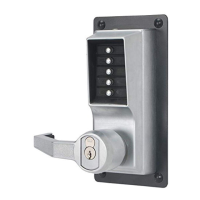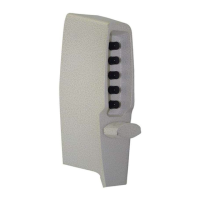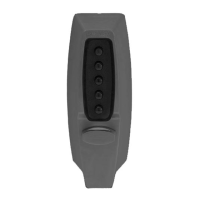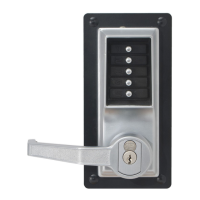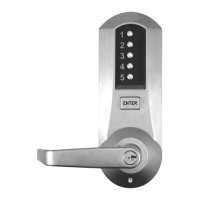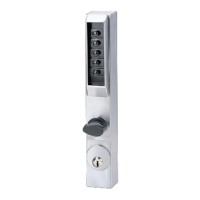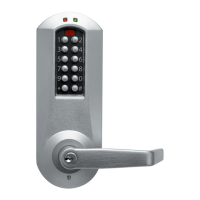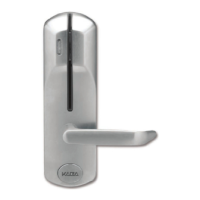La relación entre la puerta y el marco es
muy importante para el funcionamiento del
mecanismo que acciona el pestillo. Las
líneas centrales, horizontal y vertical, son
importantes al colocar la cerradura, la con-
tra y el pestillo. Deben responder a la
norma ANSI A115.2.
1. Pliegue, tal como se indica, la plantilla
de papel (en la página central de este
folleto).
2. Adhiera la plantilla a la puerta con una
cinta, de manera tal que todos los
pliegues indicados queden bien alinead-
os con el canto biselado alto de la puerta.
4(&$7&,@0 cuando un marco tiene una
contra, asegúrese de colocar la plantilla de
la contra (A), de manera tal que el centro
del agujero (A) por donde entra el pestillo
quede directamente alineado con el centro
del recorte de la contra.
3. Marque la puerta siguiendo las
indicaciones de la plantilla. Los modelos
101x y 102x sin paso libre requieren 5
agujeros; los modelos 103x, 104x con
paso libre requieren 6 agujeros B). Vea
la ilustración 1-1.
4. Quite la plantilla.
16$ para cubrir los agujeros que haya en
las puertas de madera o metal,
utilice placas de relleno.
$4&$&,@0'(.$27(46$
(4)14$&,@0'(.15$*7-(415
1. Use un taladro, con broca central de
guía, para hacer un agujero de 2
1
⁄8 pulg.
(54 mm): presione en forma uniforme
hasta que la hoja circular corte un lado
de la puerta y la punta de la broca de
guía salga por el otro lado. Luego detén-
gase.
The door to frame relationship is critical for
the performance of the latch mechanism.
The vertical and horizontal center lines are
important when positioning the lock, strike,
and latch, and all must be according to
ANSI standard A115.2.
1. Fold the paper template (found in the
middle of this booklet) on the line as
indicated.
2. Tape the template securely to the door
so that all the indicated folds are proper-
ly aligned with the high beveled edge of
the door.
.BA6<; When a frame has an existing
strike, be sure to locate the strike template
so that the latch hole center (A) is directly
aligned with the center of the strike cutout.
3. Mark the door using a center punch as
indicated on the template. Models 101x
and 102x without passage feature
require 5 holes; models 103x, 104x, with
passage feature require 6 holes (B)
(see figure 1-1).
4. Remove the template.
#<A2 To cover existing holes in wood or
metal doors a filler plate may be used.
".?86;4A521<<?
?6996;4A525<92@
1. Use a hole saw with a pilot drill bit to drill
the 2
1
⁄8" (54 mm) hole: apply pressure
evenly until the circular blade cuts the
first side of the door and the tip of the
pilot bit emerges through the other side,
then stop.
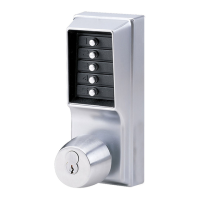
